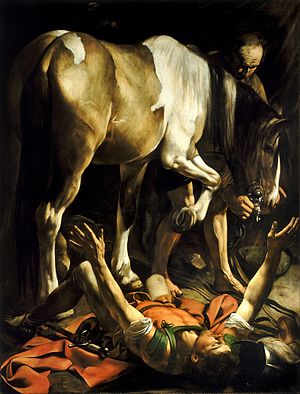Conversion on the Way to Damascus
| The Conversion on the Way to Damascus | |
|---|---|
 |
|
| Artist | Caravaggio |
| Year | 1601 |
| Medium | Oil on canvas |
| Dimensions | 230 cm × 175 cm (91 in × 69 in) |
| Location | Santa Maria del Popolo, Rome |
The Conversion on the Way to Damascus (Conversione di San Paolo) is a masterpiece by Caravaggio, painted in 1601 for the Cerasi Chapel of the church of Santa Maria del Popolo, in Rome. The painting depicts the moment recounted in Chapter 9 of Acts of the Apostles when Saul, soon to be the apostle Paul, fell on the road to Damascus. He heard the Lord say "I am Jesus, whom you persecute, arise and go into the city" (see Conversion of Paul). The Golden Legend, a compilation of medieval interpretations of biblical events, may have framed the event for Caravaggio.The Conversion of Paul depicts a moment of intense religious ecstasy. This scene shows the very moment Paul is overcome with the spirit of Jesus Christ and has been flung off of his horse.
Caravaggio's first version of the Conversion painting is in the collection of Principe Guido Odescalchi. It is a much brighter and more Mannerist canvas, with an angel-sustained Jesus reaching downwards towards a blinded Paul.
Michelangelo Merisi da Caravaggio was born in Lombardy, Italy and lived from September 1571 to July 1610. He was an Italian artist active in Rome, Naples, Malta, and Sicily between 1593 and 1610. Caravaggio introduced a powerfully frank realism with the use of dramatic lighting to Italian Baroque Art. When Caravaggio first moved to Rome in 1592, he began his career as a specialist painter of still lifes, mostly fruits and vegetables. He continued his artistic career by painting for a small circle associated with the household of art patron, Cardinal del Monte. Starting in 1600, Caravaggio had earned fame in the city of Rome. With the help of the Cardinal del Monte, Caravaggio was contracted to decorate the Contarelli Chapel in the church of San Luigi dei Francesi. From this commission, Martyrdom of Saint Matthew and Calling of Saint Matthew, delivered in 1600, were an immediate sensation. But Caravaggio was not able to bask in his fame for long, because he was exiled to Naples in 1606. Caravaggio earned fame in both Naples and Sicily after being exiled. But, with another strange sequence of events Caravaggio’s death, in the summer of 1610, was announced by an anonymous letter.
...
Wikipedia
